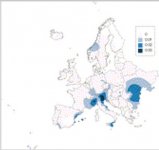Ok, so now some speculations that I feel pretty confident.
Corded Ware seems to be related to R1a folk linked to Satem language branches (Baltic, Slavic, Indian, Iranian). Baltic linguists had been speculating about (proto) Balts, Slavs, Indo-Iranians living together in forest zone (and touching Finno-Ugric tribes) since ages, based on certain linguistic, cultural and mythological cross-paralels. Nice to see dna proving or at least not contradicting that.
Of course when R1a proto-Indo-Iranians left for their journey South they admixed with many local folks before arriving to India/Iran. But they took language, culture and R1a impulse with them. Same is true for (modern) Balts who mixed with coastal Baltic natives and early Corded pioneers to create modern Balts.
A lot of things where I dont even a have clue now. First, origins of language and developments before Corded. What is the role of Cucuteni, EHG, Caucasus in creation of PIE? Did it came from East and mixed with NW Caucasian as promoted by Kourtland in his Indo-Uralic?
Many swords shall be broken until we get to where it came from

I like the idea of Yamna culture being a cocktail of many things (farmers, hunters, Caucasians, EHG, and so on). Message it gives is great and modern - Diversity is Power!
Exchange of cultures, ideas and lifestyles that produced a new global impulse.
p.s.
Another quote that I met on one of many forums that I enjoyed (originally from Anthony?), was that IE expansion seems to be rather peaceful and gradual and not Hunn like horde. This fits to what and how I see developments in Baltic.




